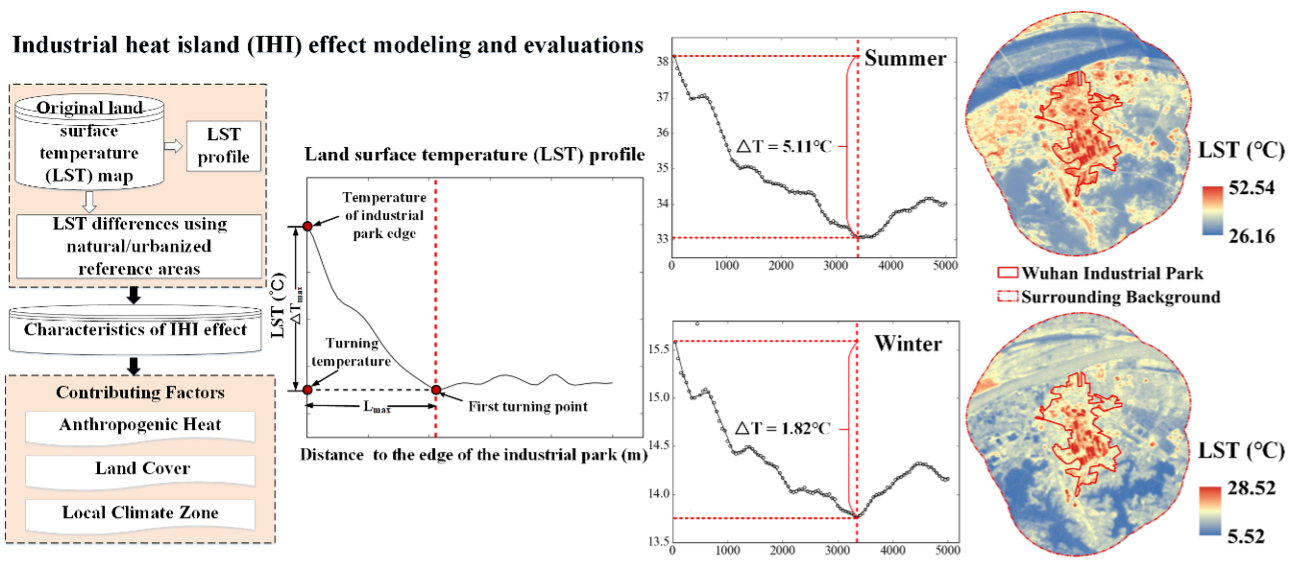New Evidence, Quantitative Methods, and Contributing Factors of Industrial Heat Island Effects
A research team led by Prof. MENG Qingyan from the National Engineering Laboratory for Satellite Remote Sensing Applications under the Aerospace Information Research Institute (AIR), Chinese Academy of Sciences (CAS), has published a paper on the Environmental Pollution on the urban intra-heat island effects. The paper tries to provide evidence, quantitative methods, and contributing factors from a spatiotemporal analysis of top steel plants in China. Prof. MENG Qingyan and doctoral candidate HU Die are the co-first authors.
The urban heat island (UHI) effect refers to the air temperature of urban areas exceeding those of their surrounding rural areas. Rising urban air and surface temperatures have affected the quality of life of urban residents, aggravated air pollution, increased the energy consumed for cooling, and negatively impacted human health. For these reasons, urban researchers are eager to develop strategies that could mitigate the further warming of urban areas. It is well known that industrial lands play a dominant role in generating high land surface temperature (LST), and hot urban regions are generally highly concentrated in industrial lands. However, few studies have explored whether clustered industrial facilities (e.g., large steel plants) generate intra-heat island effects in cities. The industrial heat island effect still lacks clear criteria. Uncertainties have persisted in recent studies.
In this context, this study proposed an effective method to quantify the warming effect derived from the urban industrial park, and the spatiotemporal analysis presented new evidence for this surface intra-heat island effect, defined as the industrial heat island (IHI) effect. The industrial parks were isolated from other artificial lands, which allowed for measuring quantifiable features related to IHIs derived from the original LST maps. Besides, a system of thermal landscape metrics was designed to characterize the thermal morphology.
The LST profiles delineated the downward trend in LST variation from inside to surroundings in the IHI cases on both spatial and temporal scales. The time-series analysis showed that the IHI effects demonstrated more significant disparities regarding the LSTs between the industrial parks and their surrounding backgrounds during warm seasons than in cold seasons. Moreover, the IHI intensity is positively associated to the anthropogenic heat, indicating that the industrial activities contribute to the increased LSTs of the industrial park to a great extent. The results of geographical detector model revealed that the anthropogenic heat determined more spatial heterogeneities of LST than local-scale landscape/land surface factors in the IHI area over different seasons.
The rationale of the IHI effect can broaden insight for understanding how urban industrial heat sources influence the regional thermal environment. According to our conclusions, this study recommends limiting industrial production tasks in warm seasons may alleviate the IHI effect to a certain extent. The research has considerable implications for modeling and evaluating the surface UHI effects, which is essential for environmental planning and urban micro-climatic research, especially at a finer scale.

Figure. The study process diagram of spatio-temporal industrial heat island effects' quantification.
This study is supported by the Key Deployment Project of the Aerospace Information Research Institute, Chinese Academy of Sciences research on the mechanism of multi-scale urban imperviousness on thermal landscape", Research on Satellite Thermal Infrared Information Extraction of Tectonic Activity and Fine Recognition Technology of Seismic Anomalies [2019YFC1509202], and High-resolution Environmental Monitoring Comprehensive Verification and Application Demonstration [05-Y30B01-9001-19/20-1].
Link to the paper: https://doi.org/10.1016/j.envpol.2021.118383.
Citation: Qingyan MENG, Die HU, Ying ZHANG, Xu CHEN, Linlin ZHANG, Zian WANG, Do industrial parks generate intra-heat island effects in cities? New evidence, quantitative methods, and contributing factors from a spatiotemporal analysis of top steel plants in China, Environmental Pollution, Volume 292, Part B, 2022, 118383, ISSN 0269-7491.



News & Events